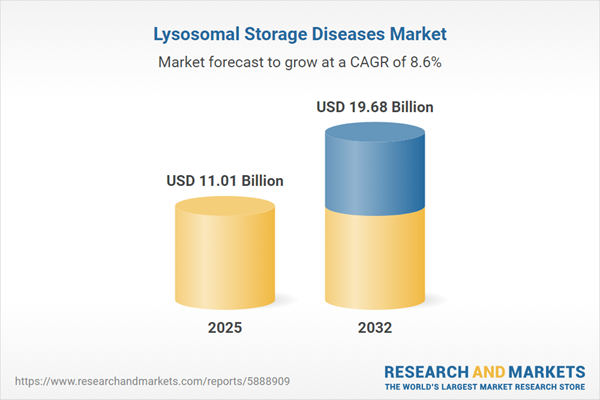Speak directly to the analyst to clarify any post sales queries you may have.
The lysosomal storage diseases market is undergoing rapid evolution as industry leaders respond to shifting clinical demands, regulatory changes, and supply chain pressures. Senior stakeholders require clear insight into market dynamics to direct investment, optimize partnerships, and align strategy to both innovation and risk.
Market Snapshot: Strategic Landscape in Lysosomal Storage Diseases
The Lysosomal Storage Diseases Market grew from USD 10.17 billion in 2024 to USD 11.01 billion in 2025. It is projected to maintain robust expansion at a CAGR of 8.60%, attaining USD 19.68 billion by 2032. The sector is shaped by complex clinical requirements and increasing demand for novel interventions. Growth is fueled by technological advancements, evolving regulatory pathways, and expanding therapeutic portfolios, reflecting the escalating importance of targeted, long-term solutions.
Scope & Segmentation
This report provides a granular analysis across the full lysosomal storage diseases value chain by segment, therapy type, application, end-user, region, and leading companies. Market coverage includes:
- Disease Types: Fabry Disease, Gaucher Disease, Hunter Syndrome, Mucopolysaccharidosis, Niemann-Pick Disease, Pompe Disease
- Treatment Types: Enzyme Replacement Therapy (Agalsidase Beta, Alglucerase, Alglucosidase Alfa), Gene Therapy, Hematopoietic Stem Cell Transplant (Allogeneic, Autologous), Substrate Reduction Therapy
- Therapeutic Applications: Cardiovascular Involvement, Central Nervous System Involvement, Hematological Disorders, Pulmonary Complications, Skeletal Deformities
- End-Users: Academic & Research Institutes, Biopharmaceutical Companies, Hospitals, Specialty Clinics
- Regions: Americas (United States, Canada, Mexico, Brazil, Argentina, Chile, Colombia, Peru), Europe, Middle East & Africa (United Kingdom, Germany, France, Russia, Italy, Spain, Netherlands, Sweden, Poland, Switzerland, United Arab Emirates, Saudi Arabia, Qatar, Turkey, Israel, South Africa, Nigeria, Egypt, Kenya), Asia-Pacific (China, India, Japan, Australia, South Korea, Indonesia, Thailand, Malaysia, Singapore, Taiwan)
- Key Companies: Abeona Therapeutics Inc., Alexion Pharmaceuticals, Amicus Therapeutics, ArmaGen, BioMarin Pharmaceutical, CHIESI USA, Denali Therapeutics, Freeline Therapeutics, Homology Medicines, Horizon Pharma, Idorsia Pharmaceuticals, JCR Pharmaceuticals, Neurogene, Novartis, Orchard Therapeutics, Pfizer, Protalix Biotherapeutics, Sangamo Therapeutics, Sanofi, Spark Therapeutics, Swedish Orphan Biovitrum, Takeda Pharmaceutical, Ultragenyx Pharmaceutical, Zevra Therapeutics
Key Takeaways for Senior Decision-Makers
- Gene therapy breakthroughs are initiating a shift toward potential long-term or curative treatment models, directly impacting investment priorities and R&D allocation.
- Stakeholder collaboration is intensifying between pharmaceutical companies, academic institutions, and contract research organizations, streamlining both clinical translation and commercial scale-up.
- Adoption of digital health and remote monitoring is enhancing trial design, access, and post-market data capture, making real-world outcomes more influential in reimbursement decisions.
- Therapeutic segmentation by disease manifestation and treatment modality is enabling more precise clinical development and tailored commercialization, aligning efforts with highest unmet needs.
- Regional market access strategies remain differentiated by maturity of healthcare infrastructure and policy environment, requiring flexible go-to-market approaches and localized pricing initiatives.
Tariff Impact: Navigating US Trade Policy Shifts
Recent US tariff changes are altering supply chain footprint, cost structures, and drug pricing negotiations for biologic and enzyme replacement products. Manufacturers are intensifying localization efforts and diversifying supplier networks to minimize risk exposure. Healthcare providers, pharmacies, and industry finance teams must anticipate inventory volatility and align with customs authorities on classification and trade agreement strategies to maintain uninterrupted patient access.
Methodology & Data Sources
This analysis leverages mixed methods, integrating primary data from interviews with clinicians, regulatory experts, patient advocates, and executives. Comprehensive secondary research includes peer-reviewed literature, public policy documents, and financial disclosures. Expert workshops validate preliminary trends to ensure robust, actionable insights. The primary keyword “lysosomal storage diseases market” anchors the research focus.
Why This Report Matters for Senior Leaders
- Clarifies emerging opportunities and critical risks across therapy innovation, supply chain, and market access scenarios for the lysosomal storage diseases market.
- Enables evidence-based prioritization and resource allocation, supporting commercial, clinical, and regulatory teams engaged in rare disease therapeutics.
- Guides strategic adaptation amid regulatory, technological, and regional changes that directly affect competitive advantage and long-term growth.
Conclusion
This report equips senior stakeholders with the evidence and insights to advance innovation and navigate complexity in the lysosomal storage diseases market. Strategic adaptation, collaboration, and technology utilization will underpin continued growth and improved patient outcomes.
Additional Product Information:
- Purchase of this report includes 1 year online access with quarterly updates.
- This report can be updated on request. Please contact our Customer Experience team using the Ask a Question widget on our website.
Table of Contents
3. Executive Summary
4. Market Overview
7. Cumulative Impact of Artificial Intelligence 2025
Companies Mentioned
The companies profiled in this Lysosomal Storage Diseases market report include:- Abeona Therapeutics Inc.
- Alexion Pharmaceuticals, Inc.
- Amicus Therapeutics,Inc.
- ArmaGen, Inc.
- BioMarin Pharmaceutical, Inc.
- CHIESI USA, Inc.
- Denali Therapeutics Inc.
- Freeline Therapeutics
- Homology Medicines, Inc.
- Horizon Pharma PLC
- Idorsia Pharmaceuticals Ltd.
- JCR Pharmaceuticals Co., Ltd.
- Neurogene Inc.
- Novartis AG
- Orchard Therapeutics Limited
- Pfizer Inc.
- Protalix Biotherapeutics Inc.
- Sangamo Therapeutics, Inc.
- Sanofi S.A.
- Spark Therapeutics, Inc.
- Swedish Orphan Biovitrum AB
- Takeda Pharmaceutical Company Limited
- Ultragenyx Pharmaceutical Inc.
- Zevra Therapeutics,Inc.
Table Information
| Report Attribute | Details |
|---|---|
| No. of Pages | 185 |
| Published | November 2025 |
| Forecast Period | 2025 - 2032 |
| Estimated Market Value ( USD | $ 11.01 Billion |
| Forecasted Market Value ( USD | $ 19.68 Billion |
| Compound Annual Growth Rate | 8.6% |
| Regions Covered | Global |
| No. of Companies Mentioned | 25 |









